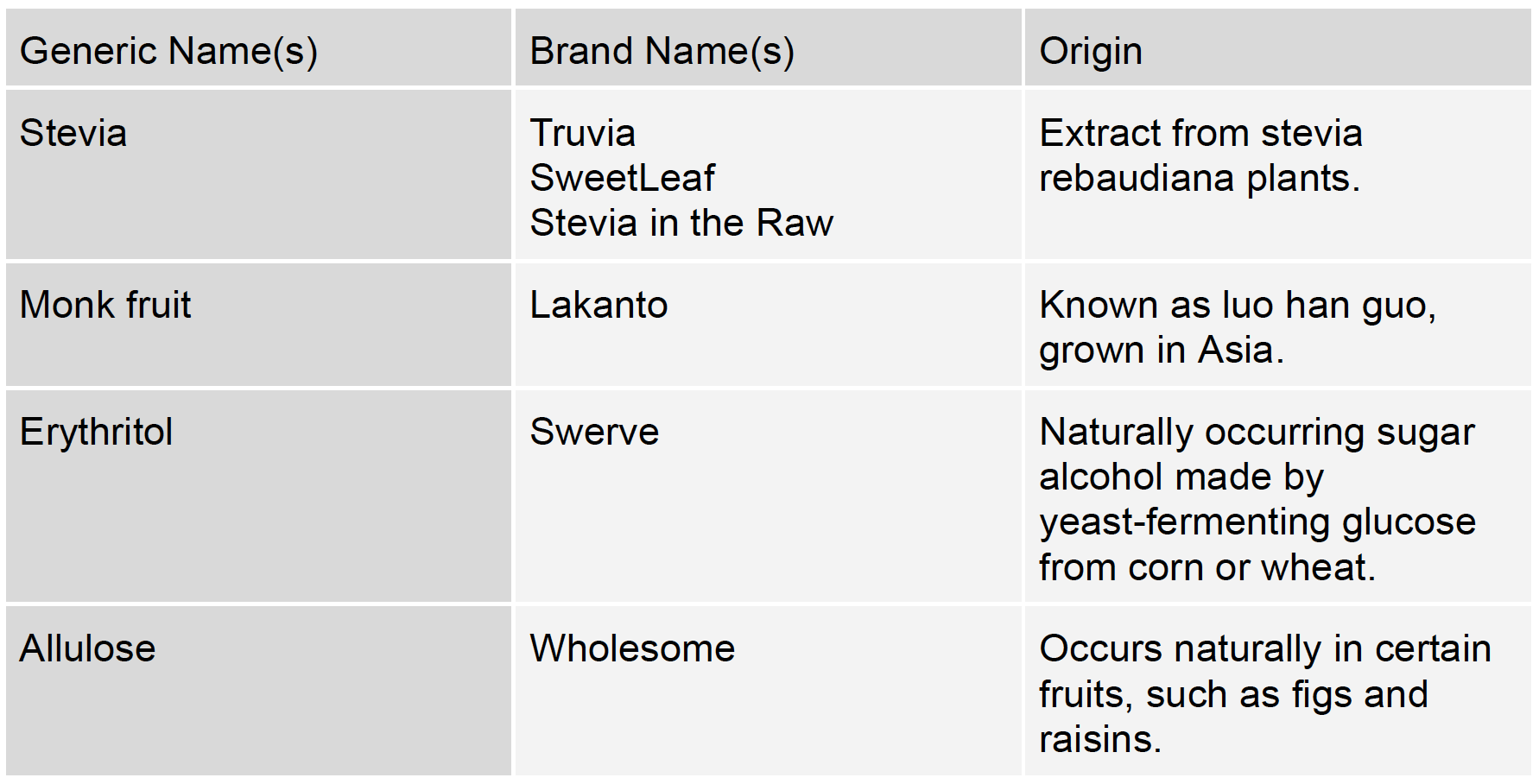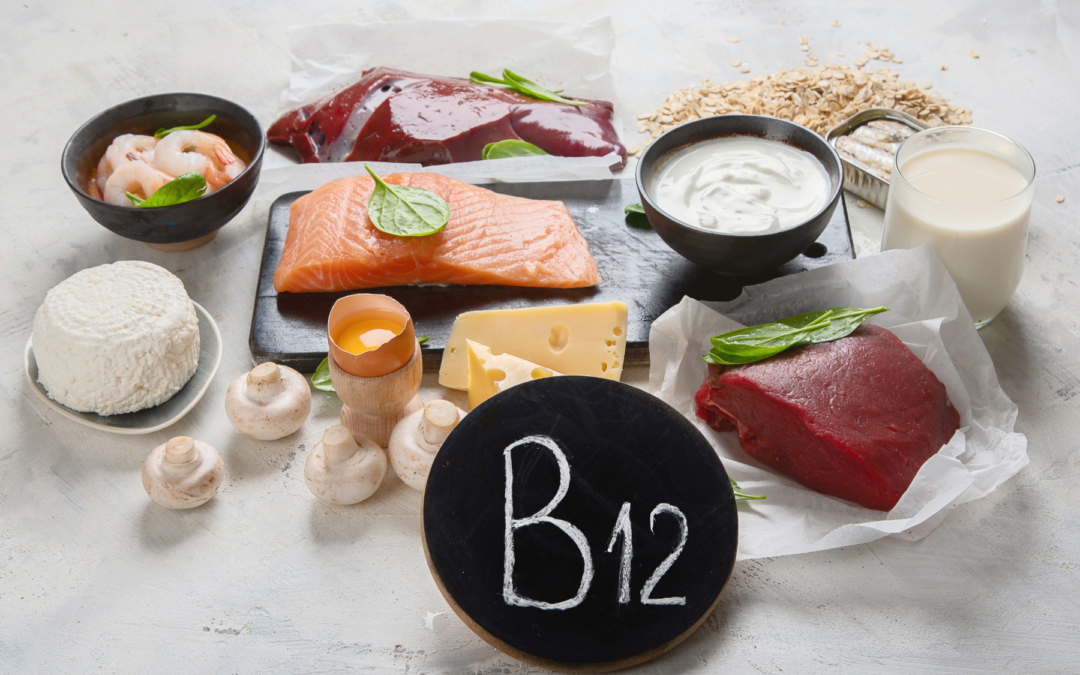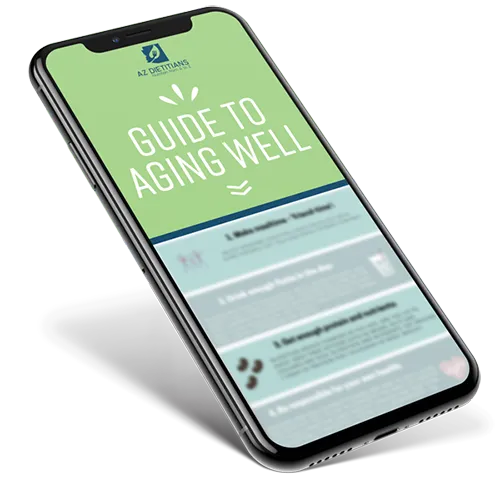Many people have begun switching out their favorite products for the “sugar-free” alternatives in order to not spike blood sugar and help manage their weight. These artificial sweeteners contain sugar substitutes in place of sucrose (also known as table sugar). These alternatives are able to mimic the taste of sugar through its high sweetening intensity while providing a negligible calorie amount.
There are a variety of artificial sweeteners:
Effects of Zero-Calorie Artificial Sweeteners
The influence of artificial sweeteners and the gut microbiome has been explored due to the well-known interaction between health, diet, and gut microbiota.
Current research suggests that the influence on the gut microbiome varies depending on the artificial sweetener, with some sugar alternatives disrupting glucose metabolism and others contributing to dysbiosis. Dysbiosis is an imbalance between the “good” and “bad” gut bacteria which may contribute to disease risk and/or poor health.1
Regular sugar may be detrimental to the gut microbiome due to feeding harmful bacteria, yet research suggests artificial sweeteners may be worse. A paper published in Physiology and Behavior presented three mechanisms through which artificial sweeteners promoted metabolic dysfunction: 2
- Interfering with learned responses that contribute to glucose control and energy balance.
- Destroying gut microbiota and inducing glucose intolerance.
- Interacting with sweet-taste receptors in the digestive system that are involved in glucose absorption and activate insulin secretion.
Additionally, researchers from Anglia Ruskin University demonstrated that artificial sweeteners can also produce pathogenic bacteria. Pathogenic bacteria are any type of bacteria capable of causing disease in the body.
Their study discovered that artificial sweeteners saccharin, sucralose, and aspartame significantly increased the formation of biofilms and increased the invasion of bacteria into the human gut cells.3
- Biofilms make bacteria less responsive to treatment and more likely to create disease.
Another Sugar Alternative: Natural Sweeteners
If you are going to have zero-calorie sweeteners, opt for Stevia (or steviol glycoside). Unlike other sweeteners which are artificial, Stevia is naturally occurring from the stevia plant – which is native to South America.
Research is limited regarding natural sweeteners’ effects on the gut microbiome, with Stevia having the most information. Stevia’s metabolism depends on gut microbiota, which breaks down glycosides into steviol that you can absorb.
- Substances in stevia (specifically stevioside) may mimic probiotic action protecting from inflammatory processes and dysbiosis through its ability to stop the production of inflammatory cytokine production.4
Natural sweetener options (without calories) include: 5
What Are Sugar Alcohols?
Sugar alcohols are carbohydrates that are part sugar and part alcohol. While some sugar alcohols occur naturally and come from fruits and vegetables, many are artificially produced to sweeten products. They are 25-100% as sweet as regular sugar and not classified as a zero-calorie sweetener like the previous sweeteners discussed, but are still low-calorie sweeteners (2.6 calories per gram).
There are currently 8 sugar alcohols that are approved for human consumption:6
- Erythritol
- Hydrogenated starch hydrolysates
- Isomalt
- Mannitol
- Maltitol
- Sorbitol
- Xylitol
Of the 8 approved sugar alcohols, erythritol, xylitol, and maltitol are the most commonly used by the food industry.
Effects of Sugar Alcohols
May Help Those with Diabetes:
Sugar alcohols can raise your blood sugar due to containing more carbohydrates compared to zero-calorie sweeteners, however, they are lower in calories and do not spike blood sugar levels as much, which may be beneficial for those with diabetes. Sugar alcohols have a lower glycemic index than sugar, which the lower the glycemic index the slower your blood sugar level rises after you consume the food.
May Cause Digestive Issues:
The main issue reported with sugar alcohols is that they can cause digestive issues/discomfort, especially when consumed in large amounts.
The body is unable to break down most sugar alcohols, so they travel to the gut where bacteria break them down. It is because of this that people may experience symptoms such as gas, bloating, and diarrhea – especially with large sugar alcohol quantities.
In addition, some sugar alcohols (such as sorbitol and mannitol) are considered fermentable oligosaccharides, disaccharides, monosaccharides, and polyols — known as FODMAPs. These types of carbohydrates can lead to digestive side effects in some people as well.
People who are sensitive to FODMAPs should avoid sugar alcohols, with the exception of erythritol. Erythritol is generally well tolerated and not considered a high FODMAP ingredient.
How to Reduce Sugar Intake
While natural sweeteners are going to be the better option compared to artificial sweeteners, no sugar or sugar substitute is healthy if consumed in excess.
Here are some ways to start reducing your daily sugar intake: 7
Decrease Intake of Sugary Drinks:
A main source of added sugar for most people is sugary drinks, which include a variety of sodas, sports drinks, energy drinks, sweetened teas, and more. Most people do not realize how much-added sugar is in these products. For example, one cup of cranberry juice typically contains 31 grams of sugar.
Some better beverage options that are naturally low in sugar include unsweetened sparkling water, herbal tea, or black/green tea.
Reduce Intake of Sugary Desserts:
Most desserts do not provide much nutrition and can spike your blood sugar, which can leave you feeling tired and hungry later and craving more sugar. There are several great low-sugar dessert options that will satisfy your sweet tooth while providing more nutritional value:
- Fresh fruit with whipped cream (such as sliced strawberries)
- Greek yogurt with cinnamon and fruit
- Dark chocolate (at least 70% cocoa)
- Jello with fruit (can top with whipped cream)
Eat Whole Foods:
Whole foods have not been processed and are free of artificial substances. These foods include whole fruits, vegetables, legumes, whole grains, and meat.
Most of the added sugar and sugar substitutes are going to come from processed food, with little/none coming from dishes prepared with whole foods.
Try cooking your meals as often as possible to avoid added sugars and increase your intake of whole foods. These meals do not have to be elaborate – they can be as simple as cooked chicken paired with roasted vegetables.
Be Careful with “Healthy” Snack Foods:
Just because products use terms such as “wholesome” and “natural” does not automatically mean that they are healthy and free of added sugar. For example, many brands of dried fruit contain high amounts of added sugar. It’s important to read the nutrition labels and opt for some healthy low sugar snack items:
- Nuts and seeds
- Jerky (no sugar added)
- Dried fruit (no sugar added)
- Hard-boiled eggs
- Fresh fruit
Limit Sugary Breakfast Foods:
Who wants to start out their day with a meal full of sugar? Many popular breakfast foods are high in added sugar – such as pancakes, waffles, muffins, and jams.
Another option is breakfast cereal, yet one report found that some of the most popular breakfast cereals contain more than half of their weight in added sugar.8 Granola is another breakfast option and is often thought of as a healthy choice, yet many brands are loaded with added sugar.
Do your best to save those sugary breakfast foods for special occasions and opt for some of these low-sugar items on a regular basis instead:
- Plain oatmeal with fresh fruit and cinnamon
- Greek yogurt with fruit and nuts
- Scrambled eggs with cheese and vegetables
- Whole grain avocado toast; can top with a sunny-side egg
Read Nutrition Labels:
Companies are required to advertise their products added sugar content on food labels, which will be listed under the carbohydrate content if that food contains added sugar.
You can also check the ingredient list of the product and the higher that sugar/sugar substitute is listed in the ingredient list the more sugar the item contains. The ingredients are listed from the highest amount to the lowest amount used by weight.
Increase Protein Intake:
Research has shown that a high-sugar diet can lead to increased appetite and weight gain, while a diet low in added sugar and high in protein and fiber can reduce hunger and promote fullness.9
Stock up on protein-rich whole foods which include meat, fish, dairy, avocado, and nuts.
Get Enough Sleep:
Lack of sleep can influence the type of food choices that you make, making you more likely to crave food items that are higher in sugar, fat, salt, and calories.
An observational study involving postmenopausal women found that a higher intake of added sugar was associated with a greater risk for insomnia.10
The Bottom Line
A staple for the American diet is added sugar, and it’s important to choose natural sweeteners over artificial sweeteners when you can. This will decrease dysbiosis in the gut, which can be vital for your overall health.
The American Diabetes Association (ADA) recommends counting half of the grams of sugar alcohols as carbohydrates because only about half get digested.11
Overall, it’s important to limit obvious signs of sugar in the diet, which includes desserts and sugary beverages, while also being mindful of the hidden sugar in products by reading nutrition labels.
If you have more questions on artificial sweeteners or would like to speak to one of our online nutrition coaches, visit our website!
Sources:
- Ruiz-Ojeda, F. J., Plaza-Díaz, J., Sáez-Lara, M. J., & Gil, A. (2019). Effects of Sweeteners on the Gut Microbiota: A Review of Experimental Studies and Clinical Trials. Advances in nutrition (Bethesda, Md.), 10(suppl_1), S31–S48. https://doi.org/10.1093/advances/nmy037
- admin. (n.d.). How Artificial Sweeteners Destroy Your Gut – Vax.Guide. Retrieved April 5, 2023, from https://www.vax.guide/2021/07/05/how-artificial-sweeteners-destroy-your-gut/
- Shil, A., & Chichger, H. (2021). Artificial Sweeteners Negatively Regulate Pathogenic Characteristics of Two Model Gut Bacteria, E. coli and E. faecalis. International journal of molecular sciences, 22(10), 5228. https://doi.org/10.3390/ijms22105228
- Kasti, A. N., Nikolaki, M. D., Synodinou, K. D., Katsas, K. N., Petsis, K., Lambrinou, S., Pyrousis, I. A., & Triantafyllou, K. (2022). The Effects of Stevia Consumption on Gut Bacteria: Friend or Foe?. Microorganisms, 10(4), 744. https://doi.org/10.3390/microorganisms10040744
- “Natural Zero-Calorie Sweeteners 101: Stevia, Monk Fruit, Erythritol, Allulose & Beyond.” Hungry-Girl, 28 Sept. 2021, www.hungry-girl.com/go-to-guides/natural-sweeteners-101#:~:text=Natural%20Zero-Calorie%20Sweeteners%20101%3A%20Stevia%2C%20Monk%20Fruit%2C%20Erythritol%2C. Accessed 4 Apr. 2023.
- What Are Sugar Alcohols, and Are They a Healthy Sugar Swap? (2021, November 12). Healthline. https://www.healthline.com/nutrition/sugar-alcohols-good-or-bad#other-benefits
- 13 Simple Ways to Stop Eating Lots of Sugar. (2021, June 6). Healthline. https://www.healthline.com/nutrition/14-ways-to-eat-less-sugar#TOC_TITLE_HDR_6
- Children’s Cereals | Environmental Working Group. (n.d.). Www.ewg.org. https://www.ewg.org/research/childrens-cereals
- Rebello, C., Greenway, F. L., & Dhurandhar, N. V. (2014). Functional foods to promote weight loss and satiety. Current opinion in clinical nutrition and metabolic care, 17(6), 596–604. https://doi.org/10.1097/MCO.0000000000000110
- Gangwisch, J. E., Hale, L., St-Onge, M. P., Choi, L., LeBlanc, E. S., Malaspina, D., Opler, M. G., Shadyab, A. H., Shikany, J. M., Snetselaar, L., Zaslavsky, O., & Lane, D. (2020). High glycemic index and glycemic load diets as risk factors for insomnia: analyses from the Women’s Health Initiative. The American journal of clinical nutrition, 111(2), 429–439. https://doi.org/10.1093/ajcn/nqz275
- Get to Know Carbs | ADA. (n.d.). Diabetes.org. https://diabetes.org/healthy-living/recipes-nutrition/understanding-carbs/get-to-know-carbs









